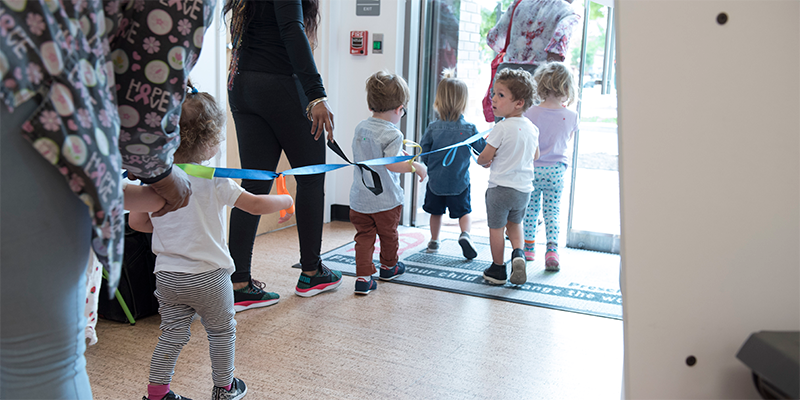
As a business leader, you’ve noticed it is becoming more and more difficult to hire and retain qualified workers. You’ve likely even considered the longer-term scenarios – will it be even more challenging to secure a reliable and productive workforce five or 10 or even 20 years from now?
You may have even spent some time – or considerable time:
- Contemplating how to successfully hire and retain workers that are growing younger by the day.
- Getting to the bottom of how the millennial generation (those born between 1981 and 1996) is different from Baby Boomers and Gen X-ers you’ve employed in the past.
- Figuring out how to attract them to your business, tap into their strengths, and offer the work environment, culture, and values to ensure they will grow and thrive in your company.
If this sounds familiar, you are not alone.
What this generational shift in our workforce is teaching us is that when it comes to recruiting and retaining a reliable and productive workforce, early childhood education and child care are now solidly part of the conversation.
Millennials comprise the population born between 1981 and 1996. An estimated 17 million millennial women are mothers, and, since 2017, millennials have comprised the largest segment of the American workforce, compared to other generations. Although millennial women have made great strides in educational attainment and career progress, they are still struggling to balance work and family life, much like women from previous generations. In a survey of millennial mothers, 74% reported that society does not do a good job of understanding and supporting mothers. This same survey found that 50% of the sample have changed their work status due to becoming a mother. Respondents most commonly cited onsite child care facilities or subsidies and longer paid maternity leave as ways employers could support them.
Why We Should Invest in Child Care
There is strong data that supports the reasons why it is important to invest in child care, such as:
- Economists have estimated the rate of return for high-quality early education to be between six and 10% per year for children in disadvantaged families. Long-term returns on investment can be as high as 16%. Investments to raise the quality of, and increase access to, child care programs for low-income families is vital for these children.
- New research estimates an annual economic cost of $57 billion in lost earnings, productivity and revenue due to the nation’s child care US businesses shoulder an economic loss of $12.7 billion each year due to child care breakdowns. The combined effect of a broken child care system and a lack of paid family leave hurts working families to the tune of $36.9 billion each year
- Research shows that child care assistance helps working parents experience fewer missed days, schedule changes and lost overtime hours. They also are able to work more hours while remaining at the same employer for longer periods, with women of all education levels being 40% more likely to remain employed after two years following the receipt of assistance for child care
- Increased earnings for parents mean immediate returns for the government, with increased tax revenue as well as positive results for businesses who invest in child care for their workers: • J.P. Morgan estimates a 115% return on investment for its child care program. • Patagonia estimates they recover 91% of their calculable costs annual calculable costs to provide child care.
There are also strong data around the negative impacts of not investing in child care, such as:
- On average, working parents with children under 5 are absent from work 13.3 days a year due to child care
- A recent economic study out of Indiana estimated that the state’s economy lost almost $1.1 billion in economic activity annually because of child care related absenteeism and turnover and almost $119 million in Indiana tax revenue.
- American businesses lose an estimated $12.7 billion annually because of their employee’s child care Nationally, the cost of lost earnings, productivity, and revenue due to the child care crisis totals an estimated $57 billion each year.
Taking Action
Once we acknowledge that child care is a wise investment in not only today’s workforce but a key to recruiting and retaining top talent in today’s competitive talent marketplace, the next step is to do something about it.
Every employer in this country, whether they realize it or not, are surrounded by experts in the early childhood education field and those experts are ready to engage in partnerships to support employers as they assess and respond to the child care needs of their workforce.
In 47 states, Child Care Resource & Referral (CCR&R) agencies focus on increasing access to high-quality, affordable child care by serving as a resource hub for families, child care professionals, and communities. Their nationwide infrastructure coupled with touch points at the local, state, and national levels, position them to be a valuable partner and guide for businesses ready to take action on child care.
The origin of the CCR&R system stemmed from a growing demand in the 1960s and 1970s for working parents to find safe and reliable child care, caused by a massive influx of women entering the workforce. These social and political forces prompted the formalization of a nationwide CCR&R system that addressed three foundational needs:
- Families’ need to access consumer education and child care referrals;
- Communities’ need to build supply and improve the quality of child care; and
- Employers’ need for a child care system that would support a productive workforce
From their inception, effective CCR&R services were based on building and sustaining high-quality, affordable child care by supporting an integrated three-fold focus on a defined set of core services for families, child care professionals, and communities and businesses in different, yet holistic and complimentary ways.
While not all CCR&Rs are exactly alike, they are designed intentionally to respond to the unique needs of their states and communities. Further, they are fundamentally nimble – poised to spot trends and take action quickly.
The next installment of this blog series details the features of the nationwide CCR&R system.
References:
- Grunewald and A.J. Rolnick, “Early childhood development: Economic development with a high public return,” Federal Reserve Bank of Minneapolis. (2003). Retrieved from https://www.minneapolisfed.org/publications/fedgazette/early-childhood-development-economic-development-with-a-high-public-return
- Belfield, C.R. (2018). The economic impacts of insufficient child care on working families. ReadyNation.
- “Solutions for Employee Child Care,” Child Action. (2015). Retrieved from http://www.childaction.org/providers/booklets/docs/ Solutions%20for%20Employee%20Child%20Care.pdf.xxxv
- Marcario, “Why should employers care about families?,” Blog, Prodigies Child Care Management.
- Economic Opportunity Institute. “How does high-quality child care benefit business and the local economy?,” Economic Opportunity Institute. Retrieved from http://www.opportunityinstitute.org/wp-content/uploads/early-learning/ELCLinkBusinessEconomy-Jul02.pdf.
- Littlepage, Laura (2018). Lost Opportunities: The Impact of Inadequate Child Care on Indiana’s Workforce & Economy
- “The US and the High Price of Child Care An Examination of a Broken System,” Child Care Aware of America. (2019)
Editor's Note: Special thanks to Mindy Bennett for her help in editing this post. The post has been cross-published to The U.S. Chamber of Commerce Foundation's blog.





